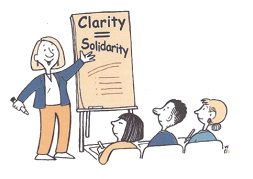Clear language is about access and inclusion
- It means making sure that our message is well-understood by everyone.
- It is about taking the experience and needs of our diverse membership into
account when we design our conference program and materials:
- members from all cultures, languages, racial and ethnic backgrounds
- women and men
- members with physical or mental disabilities
- members of all age groups
- members of all sexual orientations and gender identities.
Clear language is about cultural context
- It is about taking translation seriously and assuring accessibility in all the
languages of the conference.
- It is also about recognizing that we make assumptions about what people know
and understand based on our own cultural context. For example, if our materials
refer to a television program from the 1960s, we assume participants grew up and
went to school in Canada in the 1960s and that they are familiar with the
TV program. We exclude youth and those born and raised in other countries.
Clear language needs to be part of a larger strategy
- Using clear and inclusive language is an important aspect of promoting equality.
- An awareness of how language can reinforce the power to control and exclude
people is an important part of understanding power dynamics in society.
- Clear language can't change power relations on its own. It needs to be part of a
larger strategy for access, inclusion and equality.
Towards an inclusive conference
Clear language is one of many steps we need to take to make conferences more inclusive. In this guide,
we provide guidelines and examples (in Section Two) and resources (in Section Three). We hope they
will help make your next conference or other event more effective in reaching your goals.

